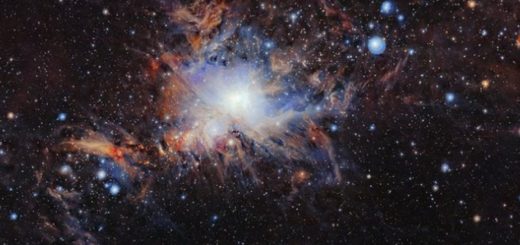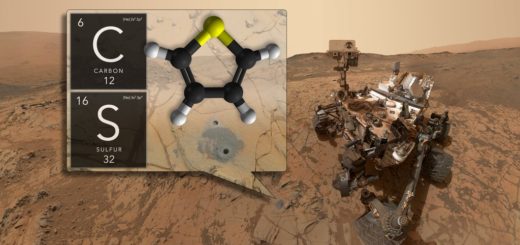Exoplanet WASP-96b Beyond Our Solar System Has Cloud-Free Atmosphere
Astronomers have detected that the ‘hot Saturn’ WASP-96b, locate beyond our solar system, is cloud-free.
An international team of astronomers, led by Dr Nikolay Nikolov from the University of Exeter, used Europe’s 8.2m Very Large Telescope in Chile, to study the atmosphere of WASP-96b when the planet passed in front of its host-star.
Researchers measured the decrease of starlight caused by the planet and its atmosphere, and thereby determine the planet’s atmospheric composition.

An artist rendition of ‘hot Saturn’ WASP-96b. A distant observer would see WASP-96b blueish in colour, because sodium would absorb the yellow-orange light from the planet’s full spectrum. Image credit: Engine House
.WASP-96b is a typical 1300K hot gas giant similar to Saturn in mass and exceeding the size of Jupiter by 20 percent.
The planet periodically transits a sun-like star 980 light years away in the southern constellation Phoenix, halfway between the southern jewels Fomalhaut (α Piscis Austrini) and Achernar (α Eridani).
“We’ve been looking at more than twenty exoplanet transit spectra. WASP-96b is the only exoplanet that appears to be entirely cloud-free and shows such a clear sodium signature, making the planet a benchmark for characterization,” Nikolay Nikolov, lead author and from the University of Exeter said in a press release.
“Until now, sodium was revealed either as a very narrow peak or found to be completely missing. This is because the characteristic ‘tent-shaped’ profile can only be produced deep in the atmosphere of the planet and for most planet clouds appear to get in the way”.
It has long been predicted that sodium (the seventh most common element in the Universe) exists in the atmospheres of hot gas-giant exoplanets, and in a cloud-free atmosphere it would produce spectra that are similar in shape to the profile of a camping tent.
Clouds and hazes are known to exist in some of the hottest and coldest solar system planets and exoplanets. The presence or absence of clouds and their ability to block light plays an important role in the overall energy budget of planetary atmospheres.
“It is difficult to predict which of these hot atmospheres will have thick clouds. By seeing the full range of possible atmospheres, from very cloudy to nearly cloud-free like WASP-96b, we’ll gain a better understanding of what these clouds are made of”, explains Jonathan J. Fortney, an astronomer and study co-author at the University of California, Santa Cruz (UCSC).
The sodium signature seen in WASP-96b suggests an atmosphere free of clouds. The observation allowed the team to measure how abundant sodium is in the atmosphere of the planet, finding levels similar to those found in our own Solar System.



 Creators of mankind
Creators of mankind Description of “Tall white aliens”
Description of “Tall white aliens” Where they came from?
Where they came from? About hostile civilizations
About hostile civilizations The war for the Earth
The war for the Earth “Tall white aliens” about eternal life
“Tall white aliens” about eternal life Video: “Nordic aliens”
Video: “Nordic aliens” Aliens
Aliens Alien encounters
Alien encounters The aliens base
The aliens base UFO
UFO Technology UFO
Technology UFO Underground civilization
Underground civilization Ancient alien artifacts
Ancient alien artifacts Military and UFO
Military and UFO Mysteries and hypotheses
Mysteries and hypotheses Scientific facts
Scientific facts


















